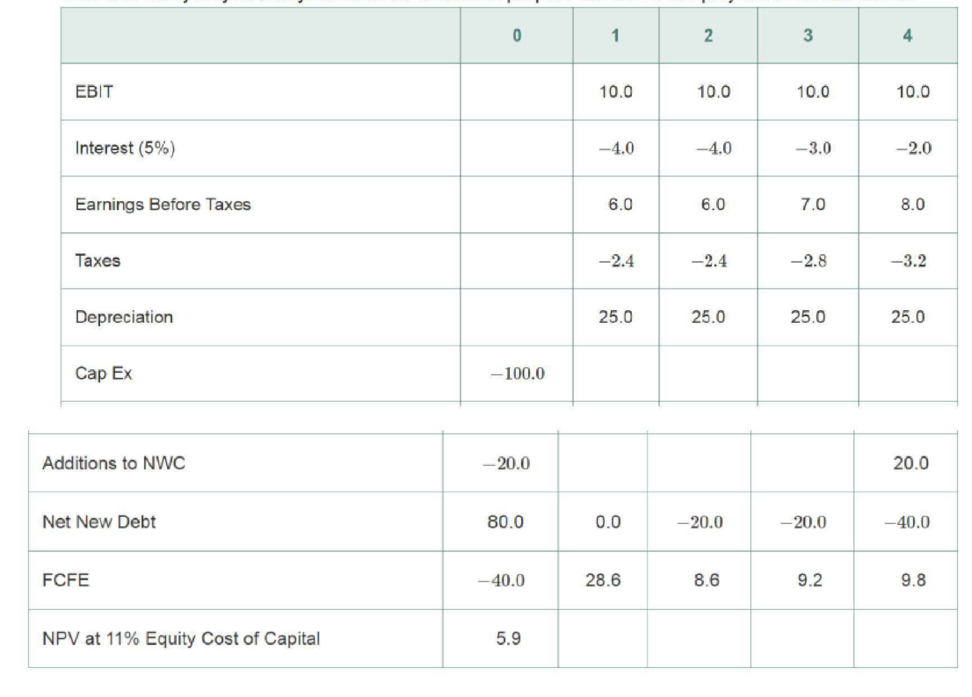
Concept explainers
You are on your way to an important budget meeting. In the elevator, you review the project valuation analysis you had your summer associate prepare for one of the projects to be discussed:

Looking over the spreadsheet, you realize that while all of the cash flow estimates are correct, your associate used the flow-to-equity valuation method and discounted the cash flows using the company’s equity cost of capital of 11%. While the project's risk is similar to the firm’s, the project’s incremental leverage is very different from the company's historical debt-equity ratio of 0.20: For this project, the company will instead borrow $80 million upfront and repay $20 million in year 2, $20 million in year 3, and $40 million in year 4. Thus, the project's equity cost of capital is likely to be higher than the firm’s, not constant over time-invalidating your associate’s calculation.
Clearly, the FTE approach is not the best way to analyze this project. Fortunately, you have your calculator with you, and with any luck you can use a better method before the meeting starts.
- a. What is the present value of the interest tax shield associated with this project?
- b. What are the
free cash flows of the project? - c. What is the best estimate of the project’s value from the information given?
Want to see the full answer?
Check out a sample textbook solution
Chapter 18 Solutions
MyLab Finance with Pearson eText -- Access Card -- for Corporate Finance (Myfinancelab)
- Would you rather have $7,500 today or at the end of 20 years after it has been invested at 15%? Explain your answer. The following are independent situations. For each capital budgeting project, indicate whether management should accept or reject the project and list a brief reason why.arrow_forwardWhich of the following should be considered when a company estimates the cash flows used to analyze a proposed project? Group of answer choices Since the firm's director of capital budgeting spent some of her time last year to evaluate the new project, a portion of her salary for that year should be charged to the project's initial cost. The company spent and expensed $10 million on a marketing study before its current analysis regarding whether to accept or reject the project. The firm would borrow all the money used to finance the new project, and the interest on this debt would be $1.5 million per year. The new project is expected to reduce sales of one of the company's existing products by 5%. The company has spent and expensed $1 million on R&D associated with the new project.arrow_forwardSuppose that you are working as a capital budgeting analyst in a finance department of a firm and you are going to evaluate two mutually exclusive projects by implementing different capital budgeting techniques. The cash flows for these two projects are given below. YEAR CASH FLOW (A) CASH FLOW (B) 0 -$17,000 -$17,000 1 8,000 2,000 2 7,000 5,000 3 5,000 9,000 4 3,000 9,500 1. Calculate the Payback Period of each project. Which project should you accept according to this method? Explain whether the Payback Period is or is not an appropriate method in this case. 2. Suppose that the discount rate is 11%. Calculate the Net Present Values (NPV) of both projects. Which project should you accept according to NPV? Evaluate your findings. 3. The crossover point on NPV profile is 12.18%. Above that point which project should you accept? Explain the relevance of the crossover point. How should you convince your boss that the NPV method is the…arrow_forward
- Suppose that you are working as a capital budgeting analyst in a finance department of a firm and you are going to evaluate two mutually exclusive projects by implementing different capital budgeting techniques. The cash flows for these two projects are given below. YEAR CASH FLOW (A) CASH FLOW (B) 0 -$17,000 -$17,000 1 8,000 2,000 2 7,000 5,000 3 5,000 9,000 4 3,000 9,500 1) Calculate the Payback Period of each project. Which project should you accept according to this method? Explain whether the Payback Period is or is not an appropriate method in this case.arrow_forwardKayla was very impressed with the cash budget/projections that you prepared for her and she has now hired you to evaluate her working capital management strategy and recommend the optimal policy mix. Kayla's Kayaks has $500,000 in assets. If she goes with a low-liquidity plan for the assets, she can earn 17%, but with a high-liquidity plan, the return will be 14%. If she goes with a short-term financing plan, the financing costs on the $500,000 will be 10%, and with a long-term financing plan, the financing costs on the $500,000 will be 12%. Given these facts, Kayla wants to know the anticipated return after financing costs with the most aggressive, most conservative, and moderate asset financing mixes. Please calculate these amounts for Kayla, explain the advantages and disadvantages of each mix, and provide a recommendation as to which mix you believe Kayla should choose (with an explanation as to why you chose that mix).arrow_forwardThe financial manager of Sarap Corporation wants to determine the amount of cash outlays to be spent for the nextperiod. He asked the help of the accountant and the latter provided a cash budget for the next year. According tothe computations, the company would be incurring cash expenses of P6,612,500 per month. The financial managerhas estimated a cost of P40 per transaction in case non-cash asset is converted to cash. The firm’s opportunity costratio is 12%.a. The optimum cash balance is?b. The average cash balance is?c. the number of conversion made during the year is?d. The total cash cost is?arrow_forward
- You are a financial analyst for the Vincenzo Company. The director of capital budgeting has asked you to analyze two proposed capital investments, Projects X and Y. Each project has a cost of $10,000, and the cost of capital for each project is 12%. The projects’ expected net cash flows are as follows: Expected Net Cash Flows Year Project X Project Y 0 ($10,000) ($10,000) 1 6,500 3,500 2 3,000 3,500 3 3,000 3,500 4 1,000 3,500 Calculate each project’s payback period, net present value (NPV), internal rate of return (IRR), and modified internal rate of return (MIRR). Which project or projects should be accepted if they are…arrow_forwardSuppose that you are working as a capital budgeting analyst in a finance department of a firm and you are going to evaluate two mutually exclusive projects by implementing different capital budgeting techniques. The cash flows for these two projects are given below. YEAR / CASH FLOW (A) /CASH FLOW (B)0 -$17,000 -$17,0001 8,000 2,0002 7,000 5,0003 5,000 9,0004 3,000 9,500 a. Calculate the Payback Period of each project. Which project should you accept according to this method? Explain whether the Payback Period is or is not an appropriate method in this case. b. Suppose that the discount rate is 11%. Calculate the Net Present Values (NPV) of both projects. Which project should you accept according to NPV? Evaluate your findings. c. Calculate the Internal Rate of Returns (IRR) for both projects (use excel). Which…arrow_forwardYou are a financial analyst for the Brittle Company. The director of capital budgeting has asked you to analyze two proposed capital investments: Projects X and Y. Each project has a cost of $10,000, and the cost of capital for each is 12%. The projects' expected net cash flows are shown in the table below. Expected Net Cash Flows Year Project X Project Y 0 – $10,000 – $10,000 1 6,500 3,500 2 3,000 3,500 3 3,000 3,500 4 1,000 3,500 Which project or projects should be accepted if they are independent? Which project or projects should be accepted if they are mutually exclusive?arrow_forward
 EBK CONTEMPORARY FINANCIAL MANAGEMENTFinanceISBN:9781337514835Author:MOYERPublisher:CENGAGE LEARNING - CONSIGNMENT
EBK CONTEMPORARY FINANCIAL MANAGEMENTFinanceISBN:9781337514835Author:MOYERPublisher:CENGAGE LEARNING - CONSIGNMENT Intermediate Financial Management (MindTap Course...FinanceISBN:9781337395083Author:Eugene F. Brigham, Phillip R. DavesPublisher:Cengage LearningPrinciples of Accounting Volume 2AccountingISBN:9781947172609Author:OpenStaxPublisher:OpenStax College
Intermediate Financial Management (MindTap Course...FinanceISBN:9781337395083Author:Eugene F. Brigham, Phillip R. DavesPublisher:Cengage LearningPrinciples of Accounting Volume 2AccountingISBN:9781947172609Author:OpenStaxPublisher:OpenStax College


